South Pacific Dream 2.0
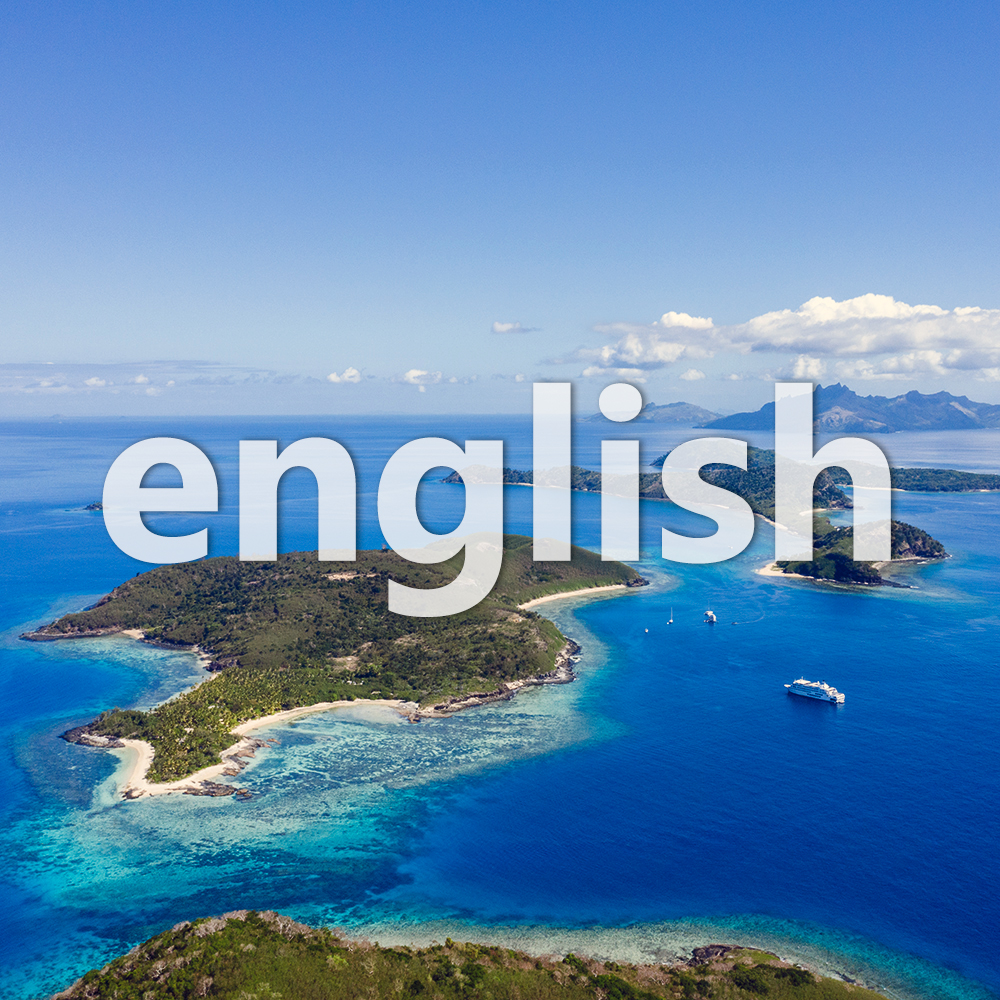
The South Seas is not a destination for Europeans. The trouble of traveling is basically only worthwhile if you have a few months to get around there. Thirty-eight hours of travel from door to door. Of that, twenty-four hours of pure flight time and fourteen hours waiting time at the airports of Berlin, Frankfurt, Singapore and Brisbane. This is the sober listing of the stations that we made on our travel to the south pacific area. We try to sleep as much as possible on the flights and airports.

Berlin Frankfurt 1 hour
Frankfurt transition 3 hours
Frankfurt Singapore 12 hours
Singapore transition 5.5 hours
Singapore Brisbane 7.5 hours
Brisbane crossing 3.5 hours
Brisbane PortVila 3 hours
35,5 hours
But as good as that may be, at least we are pretty much next to each other when we checked in at the „Moorings Hotel“ in Port Vila. We struggle up and down the beach promenade, go out for dinner and fall into a comatose sleep.
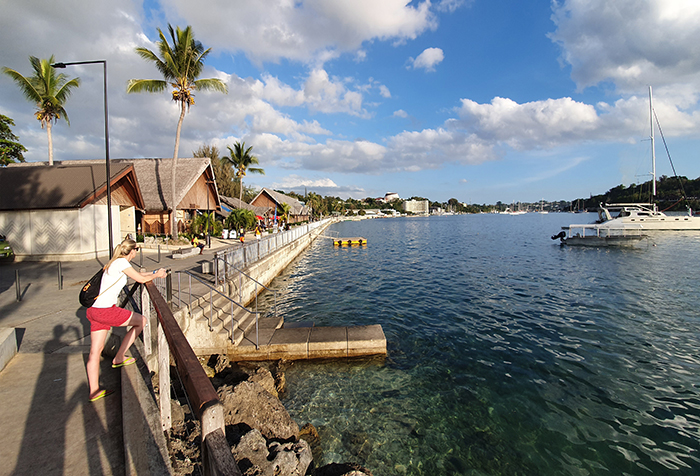
Vanuatu
In the morning, after breakfast, we hop from Port Vila airport to Tanna in thirty-five minutes. Of course, the plane is delayed by almost an hour. On Tanna we chose the „White Grass Ocean Resort“. It is not well located for tours to the volcano and there is no view of the volcano. But at the request of a single lady we have booked comfort instead of best location. The „White Grass Ocean Resort“ spares its visitors with local cuisine and offers instead excellent food for western-influenced meals. Here is also a diving center, a shop, pool and a massage parlor.
Of course our first tour takes us to the Yasur volcano. First, the pick-ups go to one, it is called probably the best tourist collection point. There, all groups from the surrounding accommodations are bundled to a ceremony. During the ceremony, the head of the village, the local tribe, is asked for permission and blessing to visit the volcano. If this permission is granted, it is followed by a ceremonial dance of the villagers, in the course of which the visitors may dance.
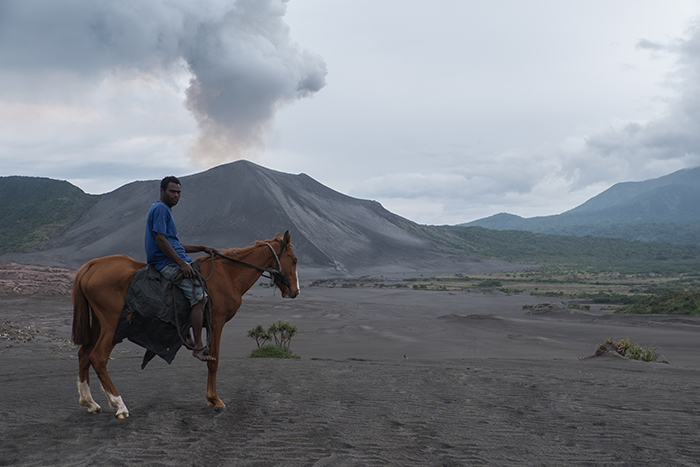
Thereafter, helmets are distributed to each visitor, which must be worn on the volcano. These plastic helmets then protect people from falling glowing lava rocks. Yes exactly! The guides who come to the volcano do not wear helmets.
Then the adventurous ride begins through a deeply cut groove, at the bottom of which lava ash forms a roadway. On some sections, the incision looks more like a washed-out river bed with deep ruts and holes. This often only progresses at a walking pace. Then the landscape will openg wide and you reach huge several ash fields on which here and there grasses and palm trees grow. At the end of the ash field rises the flank of Yasur. Here is where the vehicles park. Then begins a short easy climb to the crater rim.
Depending on the wind direction, you can then observe the natural forces of Mother Earth at close range from various viewpoints. Conscious of our minuteness and vulnerability, we are deeply impressed on the crater rim as a huge magma bubble bulges upwards and explodes with a deafening bang. In spite of its violence, the sound of the eruption only reached our ears when thousands of glowing lava spills were thrown upwards for a hundred meters. After dark, in the light of pocket lights and cell phones, the group leaves this impressive place, to which the island of Tanna owes its flourishing tourism.

We drive to Yakel, the village, that according to the locals, is the best way to gain an insight into the traditional life of the people.
we do not get five kilometers until we were stopped by a vehicle inspection by the Office for Registration and Statistics. All papers and drivers check the papers and take slip pictures with a tablet. That makes life on the islands better and safer. Worn tires, torn windscreens or broken vehicle lights are not criticized – that’s the way it is here.
At some point and somewhere we turn off the main road and drive inland. From here, the four wheel drive pickup strides at a walking speed on an extended jungle path. We cross „bridges“, which consist only of narrow iron girders, and are embedded in the in the at the distance of the vehicle trace in the sand. On both sides of the road are smaller settlements of thatched bamboo huts, where naked children play. Piglets run excitedly over the way, cows graze on the edge of the jungle and again we are prevented to drive continuing. This time around, however, it’s just a stubborn goat that has chosen the middle of the path for dozing.
One of the men in Yakel, wearing only a large penis quiver, announces our arrival by drumming on a hollow tree trunk, the Tam Tam women hurry up and spread their handmade jewelry and wooden statues on a mat. Tom, the village guide, takes us on a journey of knowledge through his world.
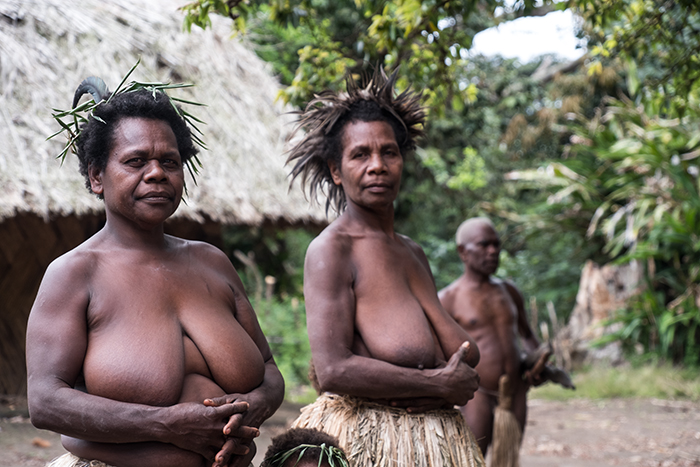
Nakula Mene is the name of the tribe that settled in the area around Yakel. The corresponding ethnic group is called Tannasoul. Five families, with about two hundred members lives here. Tom does not know exactly how many inhabitants got Yakel. Tom is very proud, because he is the father of thirteen children. Not uncommon here. Smaller fields and an estimated two hundred pigs of all sizes ensure the food supply of the village. In Yakel, however, the tourists ensure above-average prosperity. A narrow path leads us deep into a valley in the jungle. On a tree trunk we balance over a small river, which supplies not only rain but also the water for the village. Electricity and sewerage does not exist. Before we tackle the hundred meters back to the village, we take a short break at a waterfall. Tom tells us how it works with the marriage. If a couple wants to marry, then there is a bride price to pay to the family of the bride. This bride price depends on the appearance (size) and health of the woman. If a man cannot pay a bride price, at some point the village elder, the chief, determines which woman he will marry. With a ‘no’ you stay single! For our well-fed, western women, however, we would only get about ten pigs. At a value of about 150 Euros per pig, do not tempt me. Tom also tells of cannibalism that is no longer practiced on Tanna. He believes, however, that in Malekula, another island in Vanuatu, cannibalism is still a daily practice. I tell Tom that they told me the same story about Tanna in Malekula. That’s not true, but expresses how little I trust such stories.
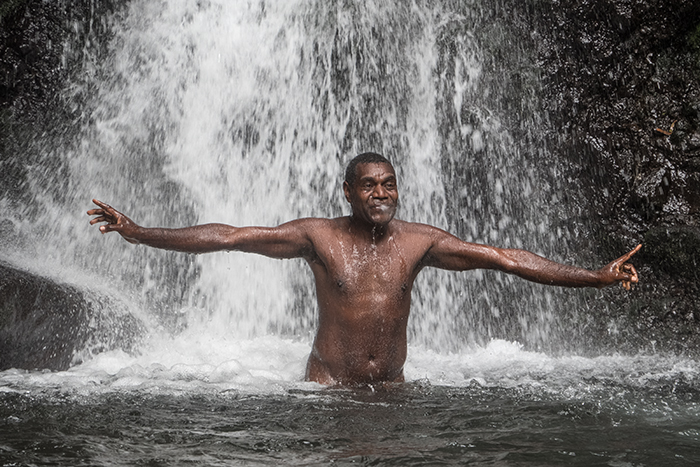
Back in the village, the „Toka-Dance“ is presented to us by women, men and children. Old Chief Jonson Kauya announced the end of the Toka Dance tradition about twenty years ago. It was probably German tourism organizers who, after his death in 2009, have stimulated the revival of this tradition. Whatever, today in Yakel you can get an idea of the culture that has been lived for centuries. The Toka Dance is not only presented as a tourist spectacle today, but also danced by the Tannasoul at their own parties.
A family of humpback whales with a cub swim along the reef in front of the resort while we have breakfast. Excited guests are standing with their mobile phones on the windows, photographing the marine mammals, which are about two hundred meters away and spend the whole morning in front of the reef.
We were hoping the weather forecast would be unreliable, but it is not. At about 2 PM, it starts to rain. Also in the past few days a few drops have fallen, but now it is monsoon-like continuous rain. In the hope that it does not rain on the other side of the island, we drive back to the volcano.
Today we have a car for ourselves. Phil is the driver and Bryant, the white grass dive instructor is also there. Briant tells us that Phil taught him to drive. Then they went to the police, gave them money and got a driver’s license. In return, Bryant Phil now teaches diving and Phil will then work as an Dive-Instructor at White Grass Ocean Resort instead of Bryant. Life is so easy here.
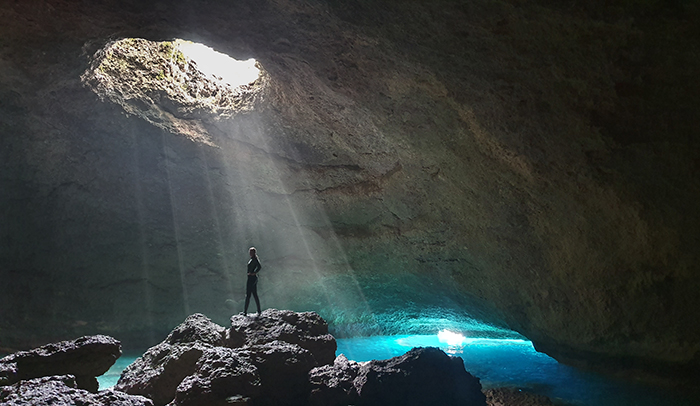
It was raining the hole night. Our clothes do not dry a bit in the humidity. My camera did not survive the night. Moisture has invaded the optics and it is unusable until further notice. While a brigade of electricians try to solve the problem with the electricity in our cabin, we make a boat trip to the Blue Cave. On the way we see a manta ray sliding just below the surface. The Blue Cave is a unique and worthwhile motive. Especially if you own a working camera.
We have electricity in the cabin again and can now start to dry things and I try to solve the camera problem.
Vanuatu is one of the most interesting islands in the South Pacific area. Nowhere else in this region can you find such a variety of cultures and nature experiences. All major islands are well connected by air and ferrys and still not over-crowded touristy. Only the weather can spoil your stay here thoroughly. We have observed the weather in Vanuatu for almost a year and it was altogether sunny for a maximum of five days. Sure, there are many travelers who have had other experiences. However, we are glad that we continue to Fiji.
How the details of the flight delay have occurred is irrelevant. There is always a reason for Air Vanuatu for delay or cancel flights. That affects about half of all flights. A professor from Sydney, who is currently working on aid projects in Vanuatu, told us that he only managed to connect to Port Vila twice from ten flights. Our flight from Tanna to Port Vila is delayed by six hours! We missed our connecting flight to Fiji. Then there bring us in a friggin dirt hotel and gave us a food voucher worth 20 Euros per person for the next 24 hours. Not even a suggestion of South Pacific feeling.
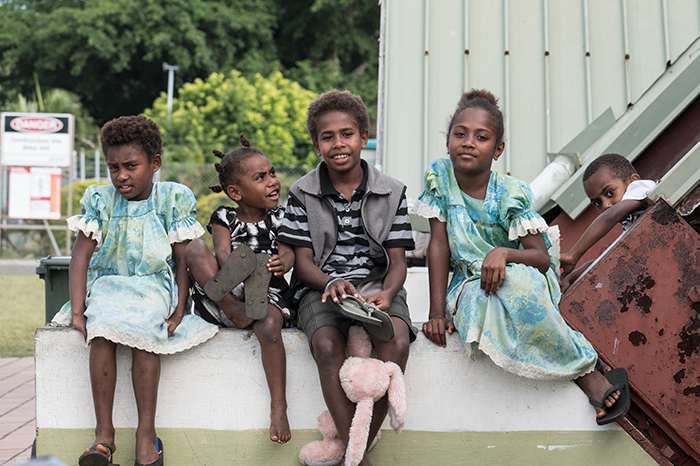
15.09.2019 Gray is the sky and it is raining. I pull a few laps in the ice-cold pool before we have breakfast. Essentially, we spend the time until noon looking for hotels, alternative flights and ferry services, so that the rest of our Fiji stay don´t goes wrong. The difficulty, however, is that internet connections on Vanuatu and other South Seas islands are not performing well. If you have a Wi-Fi connection somewhere and call a page, you can go to make a coffee, in the hope that it was been loaded during coffee time. Depending on how many users want to go online, it can happen that then nothing happens. Holidays can be so beautiful. The good news: the sun is shining now and then and it does not rain anymore. For the first time since we are on Vanuatu we wear shorts and T-shirts!
Fiji
At noon we arrive at the airport Port Vila. Other than assured by the airline, we are not booked on the flight to Nadi. It needs three and a half hours,till the Fiji Airways staff managed to give us flight tickets.
The evening, that the ATR 72-600 plane lands in Nadi, the airport is more like a lake. It is raining very hard. The airport staff bring us umbrellas, so we reach the terminal reasonably dry. We can hardly believe it, rain, wherever we go. But the taxi driver assures us, that the driest time with the least rainfall is from May to September, and it was only starts to rain in the evening this day. Point of fact, it stops to rain when we arrive at the apartment „The Terraces Apartments“. We got two bedrooms, a huge living area, three bathrooms and two balconies. The „The Terraces Apartments“ even has a 50 meter pool. Unfortunately, we cannot use all this because we lost two days and have to get tickets at seven in the morning at the ferry terminal.
16.09.2019 Bula! Welcome to Fiji. 360 picturesque South Sea islands, of which only about 100 are inhabited, offer all what we expect of the South Pacific paradise. Between white sandy beaches and coconut palms rise up to 1300 meters high mountains. An almost intact underwater world, with living corals, mantas and sharks and not least the warm-hearted people.
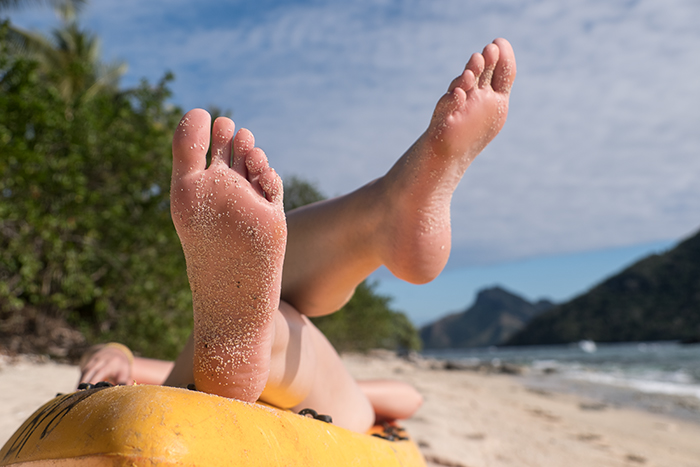
We are sitting on the upper deck of the ferry. The sun shines and the first small islands of the Yasawa archipelago appear on the horizon. Now the South pacific feeling is there.
It gets even better when we move into our luxurious tent on the beach of Kuata island. While snorkeling, we spot blacktip reef sharks and a blue-spotted stingray, as well as the many small fishes, you found on every coral reef. We drift through the afternoon, enjoying this heavenly place and have after the hardships of the past days little desire to do something. But in the evening, we go for a walk on the island, which unpredictably becomes a jungle walk, that ends at the top of a mountain. From up here we enjoy the amazing lightning of the sunset before we descend again to the camp.
17.09.2019 At a depth of 22 meters, a three meter long bull shark glides towards me and only turns off half a meter in front of my face. His silvery shimmering skin is within reach. The look in the yellow cold eyes has a hypnotic effect. He is not a killer. He is a perfect hunter and in Neptune’s kingdom the top of the food chain. Here, near the island of Kuata, you can get as close to this fascinating creature as you can to any other place in the world. I’ll never forget that incredible experience and it makes you want more. To have this experience here was my goal. That’s why I even got a diving license and it was worth the effort. Twenty-four bull sharks and two reef sharks competed for the biggest bites of the fishing lures.
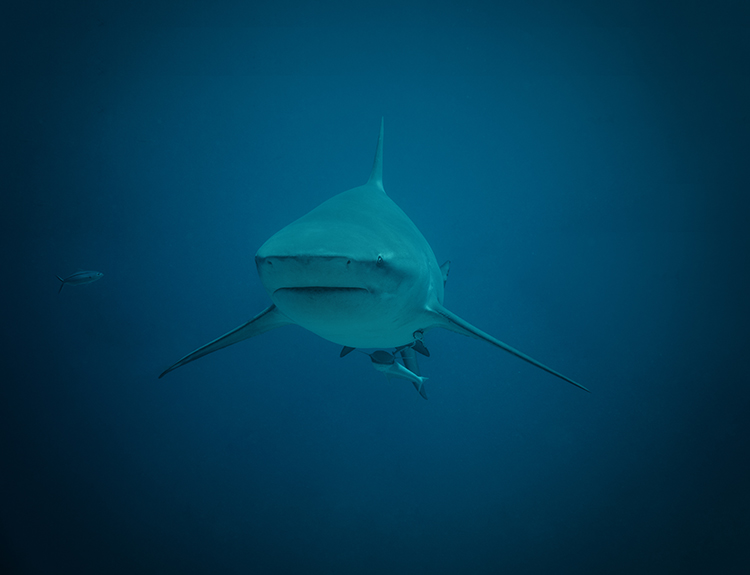
Under water, everything seems bigger than it really is and also the sense of time is distorted. I think, „filming ten minutes is enough for now.“ But it was only three minutes and I was almost disappointed to learn that the sharks I estimated at four to five meters were only three meters long. We catch up before noon and drive out to snorkel with black and white tip reef sharks. The tour is quite nice, but of course nothing compared to the dive in the morning. It essentially serves the purpose of my Caroline to bring the underwater world close, but misses the target. She, the plaything of the waves, with an empty stomach, once again made the experience, at off-shore snorkeling, you can be very seasick.
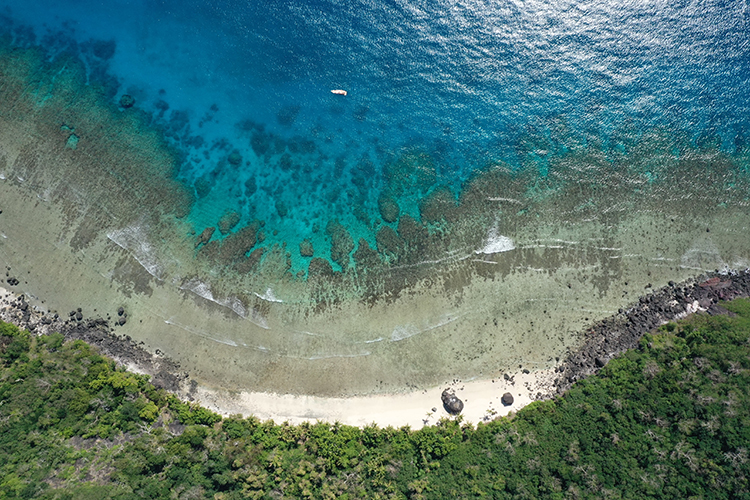
We have arrived completely in the South Pacific paradise and just chill out the rest of the day in paradise.
18.09.2019 It’s not what you did, but what you didn’t do, that you regret. Mostly at least. Following this motto, once more we head towards into the amazing underwater world with a role backwards. Even those who are not in possession of a diving license can experience the incredible shark experience at Barefoot Kuata Resort. After a short briefing, including a training session, you will go scuba-diving together with a dive-instructor. In the depth of 12 meters in the shelter of a reef, then the bull sharks are lured. We are lucky to see 17 bull sharks and a reef shark on the second dive.
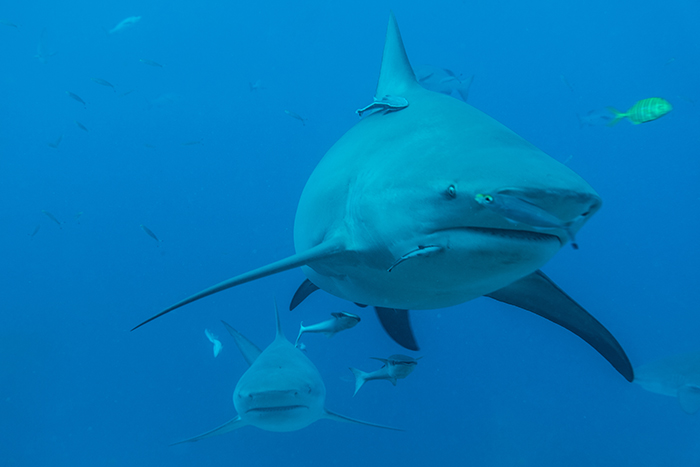
19.09.2019 The wind blows gently over the sea. White clouds move across the bright blue sky as we continue our ferry to Drawaqa Island. In bays with palm fringed beaches are resorts that are approached by the ship. Some passengers cannot wait longer and jump directly from the upper deck of the vessel into the crystal clear turquoise blue waters to swim to the beach. We get bored by boat from the ferry to the beach.
Caroline and I arrive at different lodges. My lodge is heavenly. A tent on the beach, with shower and toilet, a nice terrace with comfortable chairs on the palm trees provide shade. The restaurant is not so good like the restaurant at „Barefoot Manta“ but okay.
Caroline’s Lodge, the condition is running down, the service is shit and their accommodation is a very basic!
Both accommodations are called „Barefoot Manta“ and we both live in the same tent. But the perceptions are different.
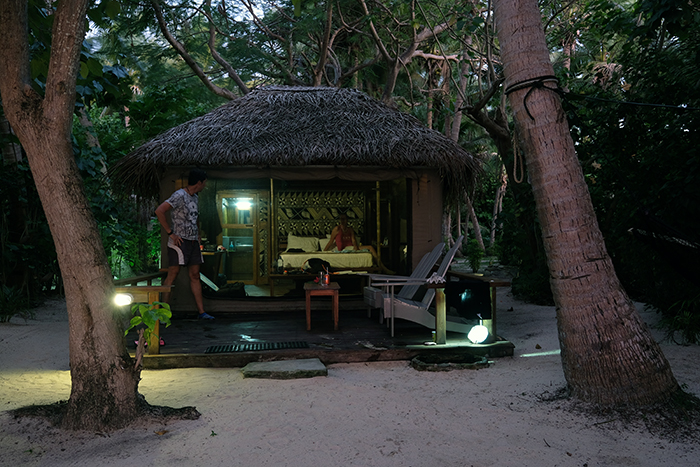
20.09.2019 Lali, is a hollow tree trunk on which the inhabitants call for ceremonies. In the „Barefoot Manta“ the Lali is beaten in the morning when the national anthem sounds and the flag is hoisted. Most guests attend this ceremony but only incidentally. Only when the Lali is beaten and the call: „Mantaray, Mantaray“ sounds in the camp, everyone jump up and run to the dive shop. A short time later, all sit in a boat and drive to the narrow channel, between the islands of Drawaqa and Naviti. This channel is one of the places where you are likely to encounter manta rays. The up to seven meters long animals, find here large amounts of plankton. With snorkeling equipment and camera we drop into the water and a minute later, one of the mantas is so close to me, that I more need a wide-lens. The group snorkels for about 20 minutes in the flow of the canal. Several times we see a couple Mantarays sliding through the water, like huge black birds fly. Sometimes just below the surface of the water and then they disappear in the bottomless blue of the ocean.
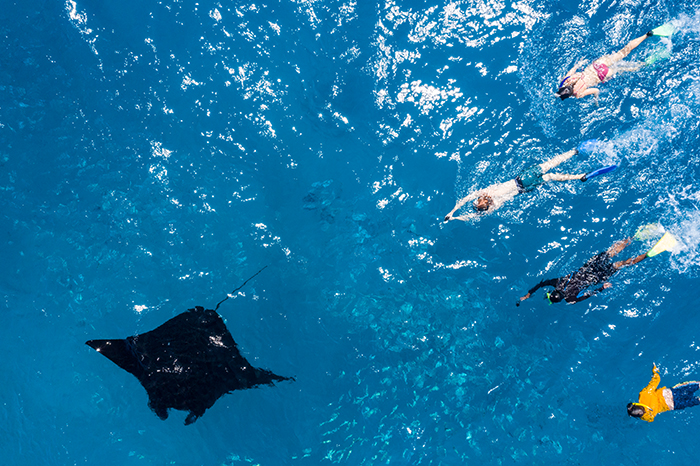
If you visit the „Barefoot Manta“, you should definitely snorkel on the east side of the island. Never before have I seen such colorful corals and so many different fishes.
21.09.2019 There are several disappointed comments on the internet of visitors of the „Barefoot Manta“, who did not see manta rays here or were in groups with about 100 other snorkelers in the water. At first we could not understand that. But today, we are ready with our snorkel gear again after breakfast and waiting for Manta-call. But nothing happens. Nobody beats the Lali. The guy who is otherwise looking for mantas with a drone is not there and the dive shop people cannot sight Mantasrays on their trips in the canal. We wait and wait. At 11:30 we realize there will not be a repeat of Manta Watching today. I spend an hour snorkeling on the east side of the island in the fabulous coral garden, before we go for lunch. The ferry then brings us back from the paradise to Denarau – habor. Past islands, white sandy beaches shine in the sun. Past reefs over which waves break roaring. Past sandbars that are now populated by seabirds at low tide. At the „Fiji Gateway Hotel“ we sleeping in, in hope that the last stop on our trip to Samoa will be just as „South Pacific dreamlike“ as our stay in Fiji.
Samoa
22.09.2019 Already on arrival at the airport, we realize that Samoa is completely different than the previously visited South Pacific islands. Our plane is the only one at the „International Airport Faleolo“. Around 40 other tourists arrive with us. The majority of them travel to the resorts on the western side of the island Upolo, hoping for sun and a free sun lounger near the pool. We’ll pick up a rotted Hyundai Accent and our ferry tickets at the airport. The drive to Apia leads over a desolate asphalt roads, through a seemingly endless village. The houses are dominated by large open halls, which are followed by smaller closed living area. Dominant are the countless churches, many with two massive towers, powerful as the towers of cathedrals. There are less interestig places in the capital Apia for tourists. Apia more is the economic and industrial center of the island state. In the 80 meter long pedestrian zone are some shops and the café „Milano“. Run by an Italian emigrant, the café is a „must go in“ for the few tourists, but the Samoans appreciate the delicious food, cakes and drinks. Once around the corner is the beautifully restored „Cathedral of the Immaculate Conception“, the only architectural highlight in Apia.

Close to the church, just behind the fish market, is the bus station. The bus drivers loves her busses, there was converted from Toyota trucks. Each driver has painted and decorated his bus to his own taste. So every bus is unique and moving icon of Samoa. As an tourist, driving in one of these buses is the best way to get closer to the life of the Samoa people.
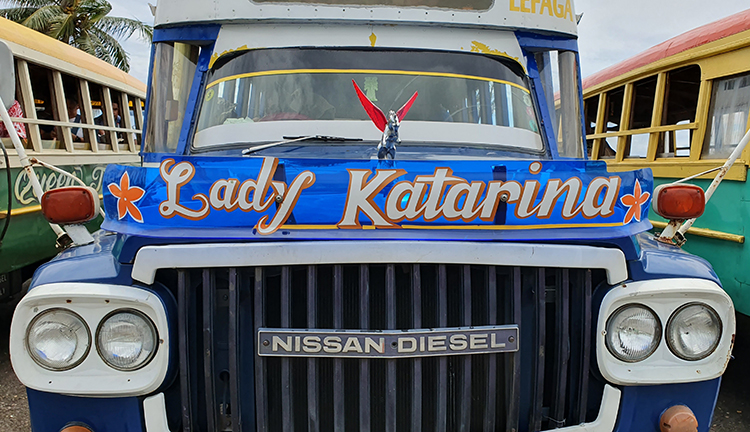
Whether policeman, schoolchild or businessman. Many prefer the skirt as a leg dress. There are even expensive tailored suits for men, which are offered instead of pants with skirt. Tattoos are also part of the culture and are proudly worn by every Samoan, including policemen and civil servants.
23.09.2019 In the morning we drive to the ferry terminal to see how much time we need and can we buy tickets for tomorrow. From Apia to the ferry you need only an hour. But it can also take two hours to adapt or adapt to the pace of Samoa drivers. Most drivers cruise with 25 kilometers per hour. If a pothole or bump occurs on the horizon, the tempo is throttled and stopped. Then we carry the vehicle over the supposed obstacle and then accelerate the car gently. Even a turn can take several eternally long minutes. Although there are signs everywhere „Keep left from the centerline“, most of them seem to be disoriented in the middle of the lane or face us head-on. The danger of a momentous accident is very unlikely, cause however, the locals just only roll slowly instead of drive. As the left-hand traffic was introduced in 2009, there were only a few sheet metal damages in the episode.
As we drive to the ferry port, we circle the island, instead of taking the „Ocean Cross Road“. First stop is the Sopoasa waterfall that plunges deep into a valley from the jungle.
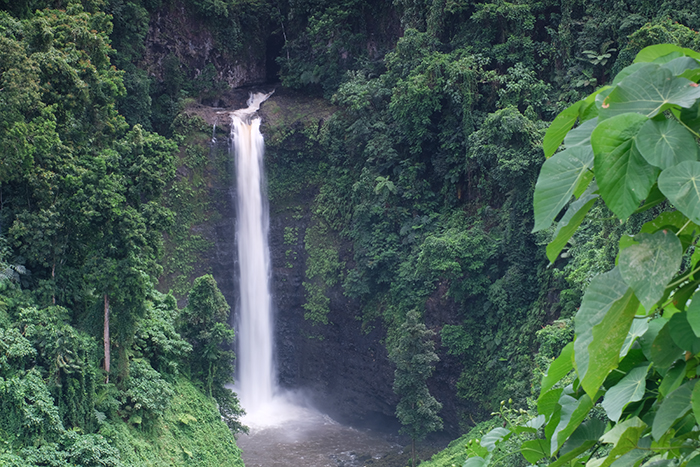
To-Sua Ocean Trench is the most visited highlight in Samoa. A rock cave that collapsed a long time ago and is open to the sea. On the Internet you will find various pictures of this place, with extremely vivid colors. The reality looks a bit different. The privately owned area around the cave is littered with various wooden railings, signs and dilapidated buildings. The restaurant is closed and the toilets are dilapidated latrines. The business-minded owner, just allows the using of mobile phones for taking pictures. Tripods, underwater housings, drones and other threatening technology are prohibited. Of course I flew! It cost us three hours to wait for the police, 60 Euros and a few nerves. Keep away of To-Sua Ocean Trench, the most overestimate place at Samoa!

The weather is getting worse. It is gray, stormy and starts to rain more and more. So we go to the elegant „Aga Reef Resort and Spa“ and have a cup of coffee and some ice-cream and a chocolate cake. But in the meantime, the weather does not improve and the Lalumanu beach, which is considered one of the most beautiful in the South Sea, looks gray and bland. The journey continues through the highlands, inside the island, where rain and fog accompany us. Only on the north side of the island can be captured for a few minutes impressions of the South Pacific idyll, before the sun goes down behind dense clouds.
Savaii
24.09.2019 The ferry-boat „Lady Samoa III“ rummages through the rough sea from Upolu to Savaii. On the rarely visited island, there is still much to discover, which has not been ridden in a touristy way. At first we notice that the people here are much nicer than those on the main island. Here you are still looking forward to visit from far away countries. When I take a photo in a village, an elderly woman sends her granddaughter to the street and invites us to her house. Cilder is 77 years old and speaks english very well. “ Salmon,“ the cat that frees the yard from rats and mice, lies at her feet and chill out. Cilder asks me why I photographed her house and where we came from. When I told her, that we are interested in the lifestyle of the people here, she tells us about her family. She has seven children, one of them lives in America and one in Australia. Her daughter in Salt Lake City has ten children. That’s too many she means. I ask them about the purpose of the hall-like buildings that each property has. This is the place who family life takes place there, when everyone returns home in the evening. The roof topped open area will used for celebrations also. She wants to know what we do on Savaii and where we live. We should be careful and drive slowly, the people here in Samoa could not drive everyone. Oh, yes, we can sign that. Then she invites us to have lunch and we would like to stay longer and learn even more, but we are only a short time on Savaii and have to go slowly.

Taga is our next destination. Here the sea meets large lava flows that once poured into the sea when this island was created. In the porous lava rock holes have been created by air inclusions and leaching. The waves press in from below water, which then shoots under high pressure out of the blowholes up in the sky. On a stormy day like today, with a high tide level, the water columns rise from the holes hissing over the tops of the palm trees on the beach. While watching the spectacle deeply, one gets the impression that the sea is getting more and more angry. With every wave that breaks thunderously against the black rock, the water penetrates a bit further and eventually the grass at the roadside is flooded. No doubt, the spirits of the seas want to pull us down into their kingdom. Some, who ventured too far to the edge, disappeared forever. The fact that the danger should not be underestimated is shown not least by the fact that the three boys who collect a small fee (5 Tala per person) for the village on the way, come looking for us at nightfall. They are frightened, that we were also a victim of the sea. The people on Savaii are much nicer and more helpful than those on Upolu.
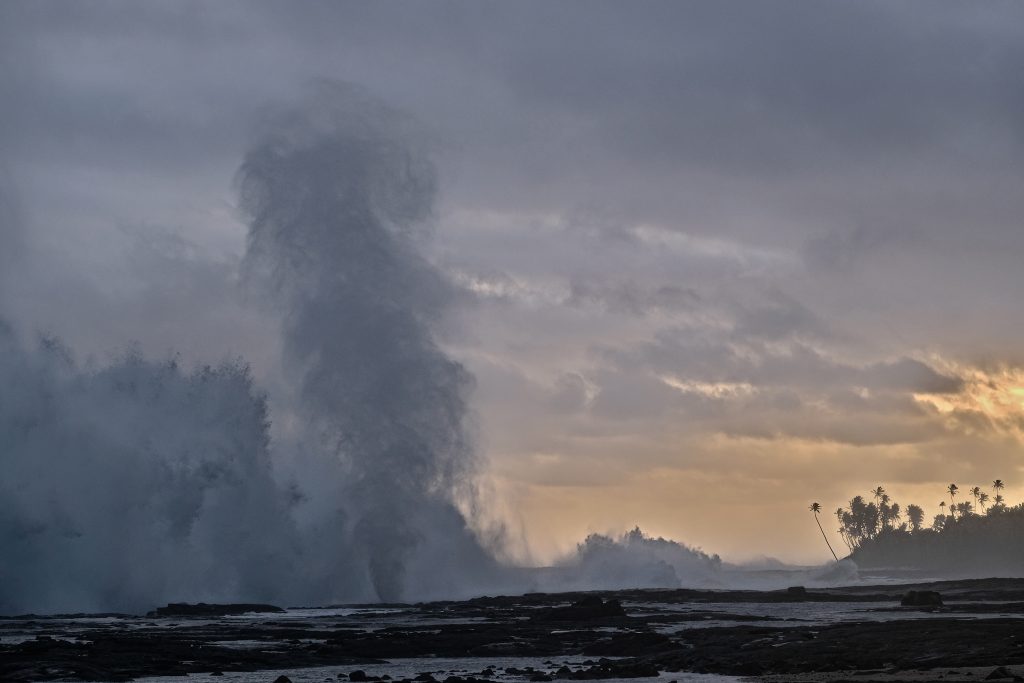
Between our visit in the morning and in the evening at the Alofaaga Blowholes, we visit three more lodges, which, however, all do not seem suitable for demanding tourists.
We still have some more time and we use them to visit the „Canopy Walk“. Two old men are waiting for visitors in a shelter. The entrance costs 20 Tala and also entitles to visit the „House of Rock“ and the „Moso’s Footprint“. On the „Canopy Walk“ you climb up giant trees and goes from one to the other over a rope-bridge. Unaccustomed perspectives on the jungle world of Savaii open up on this hike.
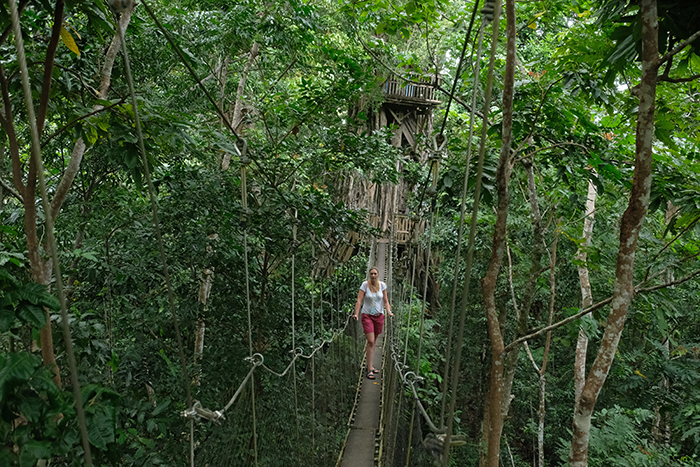
After the sunset at the „Alofaaga Blowholes“ we drive back to our lovely accommodation.
„Swimming with Turtles“
25.09.2019 It was raining the hole night and now the drops are so big that a single drop could fill a glass of water. Nevertheless, we do not lose our optimism and go to the shelter once breakfast. But it does not stop raining. We drive to the harbor and try to change our tickets for the ferry at four o’clock in the afternoon to a place on the ten o’clock ferry to Upolu. The ferry is fully booked and we are too far back in the line. Since we do not want to wait four and a half hours for the two o’clock ferry, we decide to continue exploring the island and its accommodations. At first we fear that in constant rain here we only waste time and gasoline. But how farther we go westbound on the north side of the island, the weather gets better. It stops raining and there is a chink of blue of the sky between the clouds. Short time later, the sun is shining permanently and the temperature has risen from 27 ° Celsius to 31 ° Celsius. The humidity is at 99 percent and nothing of our clothes dries. In the car its smells rotten. As we soon have to pack up, we transform the interior of the car into a tumble dryer. We continue drive up the coast. This side of the island is rich in sandy beaches, sheltered bays and beach tales. Here you will find lodges with different standards, but at least for the moment they are hardly used. Sometimes there are times only on pre-order. The „Stevensons at Manase“ hotel advertises a café and cake. But there is no cake and the coffee mashine is broken. Similarly disappointing is the „Le Lagato“ lodge. A gleam of hope is „Asaga Netta’s Cafe Bed & Breakfast“. There are always fresh dishes, a working coffee mashine and cake from the refrigerated display case. Basically, however, applies to all accommodations on Upolu and Savaii, that the photos and descriptions suggest „Bookingdotcom“ something different than it then in reality.
It´s a strange feeling to swim with turtles by the „Swimming with Turtles“ farm. It is a private zoo, whose business model is to keep turtles in captivity for tourist. Is also hard to find turtles in the open water and we want to make the experience. While swimming with the turtles in a 50-square meter pool, you can see how much power the animals have in their fins and how gracefully they glide underwater.
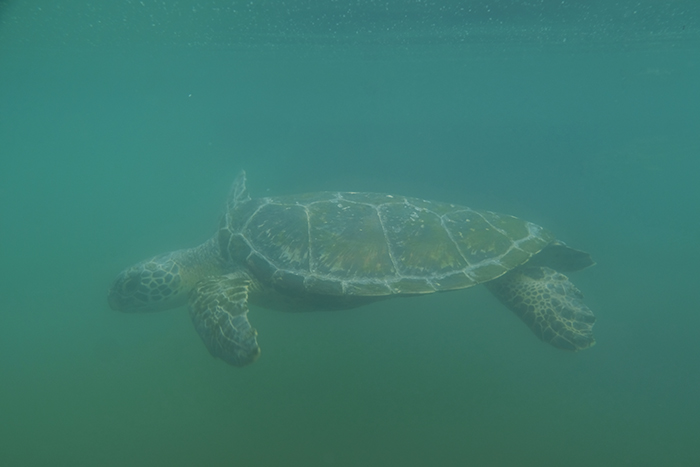
In the afternoon, we return to the square where the vehicles set up for the ferry crossing. This time it’s a smaller ferry boat, that fits only six trucks and five cars. The vehicles are secured with wooden wedges and only one of the trucks is secured with chains by its driver. The small ship is vulnerable to waves and so we lurch over the open sea for one and a half hours, while the trucks sway and teeter in beat of the ocean.
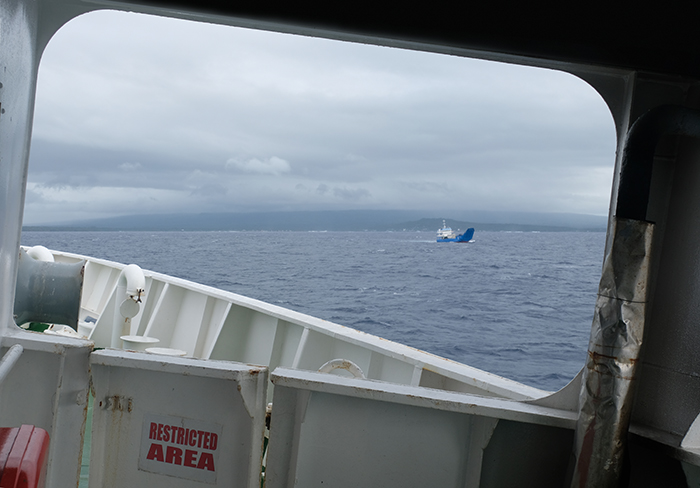
Despite the bad weather, we tried to wrest the maximum from the islands of Upolu and Savaii. The two islands are in our opinion a tourist developing country. Here you still feel like an adventurer and explorer. A feeling that the tourist hotspots cannot offer for a long time.
Apia – Auckland 4 hours
Stoppover Auckland 20 hours
Auckland – Singapore 11 hours
Singapore Transition 4 hours
Singapore – Munich 12,5 hours
Munich Transition 1 hour
Munich – Berlin 1 hour +30 minutes delay
Luggage did not arrive + 1 hour lost time
57.5 hours



Schreibe einen Kommentar